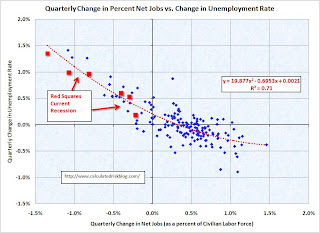by Calculated Risk on 8/28/2009 10:23:00 AM
Friday, August 28, 2009
Unemployment and Net Jobs
Next Friday the BLS employment report for August will be released.
Last month, when the unemployment rate dipped slightly to 9.4% from 9.5% in June, there were several articles like this one from the LA Times: Unemployment rate decline may indicate the recession has hit bottom.
Earlier I pointed out that the dip in unemployment was just monthly noise: Jobs and the Unemployment Rate
FAQ: How can the unemployment rate fall if the economy is losing net jobs, especially since the population is growing?Here are a couple of scatter graphs to illustrate this point ...
This data comes from two separate surveys. The unemployment Rate comes from the Current Population Survey (CPS: commonly called the household survey), a monthly survey of about 60,000 households.
The jobs number comes from Current Employment Statistics (CES: payroll survey), a sample of approximately 400,000 business establishments nationwide.
These are very different surveys: the CPS gives the total number of employed (and unemployed including the alternative measures), and the CES gives the total number of positions (excluding some categories like the self-employed, and a person working two jobs counts as two positions).
...
[T]he jobs and unemployment rate come from two different surveys and are different measurements (one for positions, the other for people). Some months the numbers may not seem to make sense (lost jobs and falling unemployment rate), but over time the numbers will work out.
The first graph shows the monthly change in net jobs (on the x-axis) as a percentage of the civilian workforce, and the change in the unemployment rate on the y-axis.
The data is for the last 40 years: 1969 through July 2009.
 Click on graph for large image.
Click on graph for large image.Obviously there is a correlation - the more jobs added (further right on the x-axis), the more the unemployment rate declines (y-axis). And generally the more jobs lost, the more the unemployment rate increases.
But the graph sure is noisy on a monthly basis.
If the economy added 0.2% net jobs in one month (as a percent of the civilian workforce, or about 300 thousand net jobs currently), the unemployment rate could increase 0.2% or decrease 0.4% - and still be within the normal scatter.
The second graph covers the same period but on a quarterly basis:
 Now we see a much sharper correlation.
Now we see a much sharper correlation.The Red squares are the for 2008, and the first two quarters of 2009. This recession fits the normal pattern.
If the economy loses about 200 thousand jobs per month in August and September, this relationship suggests the unemployment rate will probably be close to 10% by the end of September.
This also suggests the economy needs to be adding about 0.33 percent of the civilian workforce per quarter to keep the unemployment rate from rising. That is about 170 thousand net jobs per month.
Note that the trend line is a 2nd order polynomial (equation on graph). When the economy starts to add jobs, more people start looking for work - and the relationship between net jobs and unemployment rate is not linear.
 This graph show the employment-population ratio; this is the ratio of employed Americans to the adult population.
This graph show the employment-population ratio; this is the ratio of employed Americans to the adult population.Note: the graph doesn't start at zero to better show the change.
The general upward trend from the early '60s was mostly due to women entering the workforce.
This measure fell slightly in July to 59.4%, the lowest level since the early '80s. However once the economy starts adding jobs, more people will be looking for work, and the employment-population ratio will start to increase. This means the stronger the economy, the more net jobs required each quarter to lower the unemployment rate by the same amount (as shown on the 2nd graph above).
The bottom line is the unemployment rate will still increase, and we will probably see 10% later this year.


